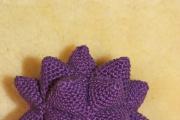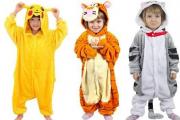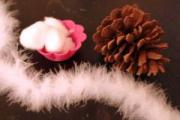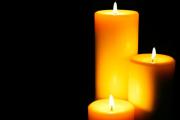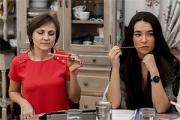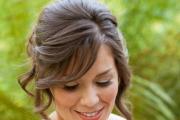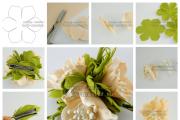Color scheme: what color goes with pink? What goes with red in the interior? (photo).
Choosing clothes of the same color always looks a little boring. Another thing is the combination of colors in clothes! Learning to combine colors and shades. Stylists recommend using a maximum of three colors. One of them will dominate the image, the second will emphasize and shade it, and the third will place accents, depending on what needs to be emphasized. 1. Monochromatic combination. Only one color is used, but with all the variety of tones, from the lightest to the darkest. The so-called consonance of shades is very important. They must be in one color range. For example, if you like the color blue, then experiment with it. It is associated with purple, green and blue. Shades may be closer to the first, second or third. Change in various details clothing its brightness, saturation, i.e. the presence of dark and light tones. It can be neon or color sea wave, as well as cornflower blue, sky blue, azure. Shade names purple conveyed through the names of flowers: lilac, violet, lavender and lilac. Turquoise, light green, aquamarine, emerald and olive are shades of green. And if the soul lies to orange color, then you have the following palette of colors: honey, red, carrot, orange, amber (includes a group of shades from yellow to brown), brown, which is obtained by merging gray and orange. And red has scarlet, pink, carmine, burgundy, crimson, crimson and cardinal. 2. Achromatic. Black, gray and white are used. And add bright color accents with accessories - brooches, bracelets, scarves. The best part is that these colors go with absolutely any color. For classic version enough white and black. What would you prefer in in this case- dark top and light bottom or vice versa - your business. Based on the characteristics of your figure (white makes you look fat, black makes you look slim). 3. Complimentary. Creative people especially like this combination, because it allows them to combine contrasting colors. Creative people, as practice and surveys show, they prefer three main pairs of colors in clothing: orange and blue, purple and yellow, red and green. By combining such contrasting colors, you will add dynamics to the image and attract attention to yourself. However, many people think that the combination of red and green in clothes looks too tasteless. But in this case it is important to choose the right shades. For example, scarlet and emerald. If your courage or type of appearance does not allow you to wear contrasting colors - ultramarine with orange, for example - try combining sky blue, lilac with light brown. How to use the color wheel as a guide.
 1.
Colors in close proximity to each other (for example, yellow and yellow-orange, yellow and yellow-green, violet and blue-violet, etc.) 2.
Colors that are at 90 degrees to each other (for example, yellow and red-orange, blue and purple, red, green and orange, etc.) 3.
Colors opposite each other (for example, yellow and purple, blue and orange, red and green, etc.) 4.
Colors that form a T (for example, blue, orange and violet-red, yellow, violet, red, orange, yellow, blue-green and red-orange, etc.) 5.
Colors that form an X (such as blue, orange, violet, red, yellow, violet, blue-green and red-orange, etc.)
1.
Colors in close proximity to each other (for example, yellow and yellow-orange, yellow and yellow-green, violet and blue-violet, etc.) 2.
Colors that are at 90 degrees to each other (for example, yellow and red-orange, blue and purple, red, green and orange, etc.) 3.
Colors opposite each other (for example, yellow and purple, blue and orange, red and green, etc.) 4.
Colors that form a T (for example, blue, orange and violet-red, yellow, violet, red, orange, yellow, blue-green and red-orange, etc.) 5.
Colors that form an X (such as blue, orange, violet, red, yellow, violet, blue-green and red-orange, etc.)  (website - hint with color wheel) http://colorschemedesigner.com/ Color combinations: White: goes with everything. Best combination with blue, red and black. Beige: with blue, brown, emerald, black, red, white. Grey– base color, goes well with moody colors: fuchsia, red, purple, pink, blue. Pink– with brown, white, mint green, olive, gray, turquoise, soft blue. Fuchsia (dark pink)– with grey, tan, lime green, mint green, brown. Red– suitable for yellow, white, brown, green, blue and black. Tomato red: blue, mint green, sandy, creamy white, gray. Cherry red: azure, gray, light orange, sand, pale yellow, beige. Raspberry red: white, black, damask rose color. Brown: bright blue, cream, pink, fawn, green, beige. Light brown: pale yellow, creamy white, blue, green, purple, red. Dark brown: lemon yellow, blue, mint green, purple pink, lime green. Tan: pink, dark brown, blue, green, purple. Orange: blue, blue, lilac, violet, white, black. Light orange: gray, brown, olive. Dark orange: pale yellow, olive, brown, cherry. Yellow: blue, lilac, light blue, violet, gray, black. Lemon yellow: cherry red, brown, blue, gray. Pale yellow: fuchsia, gray, brown, shades of red, tan, blue, purple. Golden Yellow: grey, brown, azure, red, black. Light green: golden brown, brown, pink, dark orange, dark blue, gray. Olive: orange, light brown, brown. Green: golden brown, orange, light green, yellow, brown, gray, cream, black, creamy white. Salad color: brown, tan, fawn, grey, dark blue, red, grey. Turquoise: fuchsia, cherry red, yellow, brown, cream, dark purple. Electrician beautiful with golden yellow, brown, light brown, gray or silver. Blue: red, gray, brown, orange, pink, white, yellow. Dark blue: light lilac, blue, yellowish-green, brown, gray, pale yellow, orange, green, red, white. Lilac: orange, pink, dark purple, olive, gray, yellow, white. Dark purple: golden brown, pale yellow, grey, turquoise, mint green, light orange. Black versatile, elegant, looks in all combinations, best with orange, pink, light green, white, red, lilac or yellow. Avoid: Green and blue; Brown and black; Red and pink, lilac or violet; Dark blue and black; Plum and purple; Lavender and parma color. Visual material:
(website - hint with color wheel) http://colorschemedesigner.com/ Color combinations: White: goes with everything. Best combination with blue, red and black. Beige: with blue, brown, emerald, black, red, white. Grey– base color, goes well with moody colors: fuchsia, red, purple, pink, blue. Pink– with brown, white, mint green, olive, gray, turquoise, soft blue. Fuchsia (dark pink)– with grey, tan, lime green, mint green, brown. Red– suitable for yellow, white, brown, green, blue and black. Tomato red: blue, mint green, sandy, creamy white, gray. Cherry red: azure, gray, light orange, sand, pale yellow, beige. Raspberry red: white, black, damask rose color. Brown: bright blue, cream, pink, fawn, green, beige. Light brown: pale yellow, creamy white, blue, green, purple, red. Dark brown: lemon yellow, blue, mint green, purple pink, lime green. Tan: pink, dark brown, blue, green, purple. Orange: blue, blue, lilac, violet, white, black. Light orange: gray, brown, olive. Dark orange: pale yellow, olive, brown, cherry. Yellow: blue, lilac, light blue, violet, gray, black. Lemon yellow: cherry red, brown, blue, gray. Pale yellow: fuchsia, gray, brown, shades of red, tan, blue, purple. Golden Yellow: grey, brown, azure, red, black. Light green: golden brown, brown, pink, dark orange, dark blue, gray. Olive: orange, light brown, brown. Green: golden brown, orange, light green, yellow, brown, gray, cream, black, creamy white. Salad color: brown, tan, fawn, grey, dark blue, red, grey. Turquoise: fuchsia, cherry red, yellow, brown, cream, dark purple. Electrician beautiful with golden yellow, brown, light brown, gray or silver. Blue: red, gray, brown, orange, pink, white, yellow. Dark blue: light lilac, blue, yellowish-green, brown, gray, pale yellow, orange, green, red, white. Lilac: orange, pink, dark purple, olive, gray, yellow, white. Dark purple: golden brown, pale yellow, grey, turquoise, mint green, light orange. Black versatile, elegant, looks in all combinations, best with orange, pink, light green, white, red, lilac or yellow. Avoid: Green and blue; Brown and black; Red and pink, lilac or violet; Dark blue and black; Plum and purple; Lavender and parma color. Visual material:







































The influence of flowers on humans is a scientifically proven fact. In order to live comfortably, you need to choose the right combination flowers in the interior. It is not so easy. There are special rules that must be followed in order for the colors to be compatible. There are also ready-made tables that make the whole process easier.
Principles and types of formation of combined colors
There are a huge number of shades of colors in nature. But, as you probably noticed, not all of them look equally good next to each other. Some would seem unexpected combinations They’re simply mesmerizing, and you’d rather want to look away from others. This is because when choosing flowers for the interior, flower bed, bouquet, clothing, you must be guided by certain rules and principles.
The palette of combined colors can range from two to seven colors and shades
To make them easier to remember, special tools were created - a color wheel and tables of combined colors. Basically, the main tool is the circle and the tables are finished result selection according to it. If you want to learn the basics of color combinations, use a wheel. Otherwise, select an option from the tables.
Color wheel and rules for its use
The color wheel has three levels. It contains the primary colors - red, blue, yellow. They are called primary. Their pairwise combination gives three additional (secondary) colors - purple, orange, green. On the third level there are tertiary colors is the result of a combination of secondary and primary. Based on these colors, a combination of colors in the interior (and not only) is selected.

Color compatibility circle - for selecting basic colors for the interior
As you can see, black, gray and white are not represented in the circle. They're in pure form do not exist in nature, when decorating the interior they can be used as basic (white and gray) or additional.
Number of colors
Before explaining the rules for using the color wheel, you need to understand the number of colors for them. harmonious combination. In general, you can use two, three or four compatible shades. You can also add universal colors to them - white, gray, black. This is exactly what decorators and artists do.

There are many colors, but in one interior they look harmonious. This is because they were chosen correctly - they are combined with each other
But for the interior, two shades are too monotonous and boring. Much more interesting are rooms decorated with a combination of three, four or more colors. However, it is wrong to use colors in equal proportions. One or two of them are chosen as the main ones, there are “many” of them. These colors are used to paint walls and floors; they are present in furniture upholstery and textiles. One or two more are used as additional ones. There are not many of them, but they are noticeable. The rest - no matter how many there are - serve to add variety and emphasis. They are present in small quantities- these are decorative details, pillows, etc. If you take a closer look at the interiors that you like, you will most likely find this pattern in the distribution of colors.
Combination of colors in the interior based on the color wheel
Using a color wheel, you can use it to choose colors to match. They do this according to certain rules. There are several principles for forming combinations:

Using these principles alone, several dozen combinations can be formed. But there are also extremely distant pairs and four colors that can be combined. This also adds to the number of options.

But that's not all. Each of the colors in the circle varies in saturation - from lighter in the middle to darker on the outside. That is, in the selected sector you can select several shades by tone. This combination of colors in the interior is called monochrome. They are also used in design.

Within one color, you can take several shades, add touches of neutral colors - and your monochrome interior is ready
Playing with color is sometimes interesting. And so as not to be too boring, you can use “universal” ones as accents - black, white, gray or red - to taste, depending on the desired mood and purpose of the room.
Tables of color combinations in the interior
It may be interesting to choose the combination of colors in the interior yourself, but due to ignorance you can make mistakes. For simplicity, tables have been created that simplify the creation of the interior. Especially if you know how to use them.

Table of color combinations in the interior - several options
In color tables, the combination of colors in the interior is given in five to six shades. They must be used keeping in mind the rule. The first shade is the main color, the second and third are additional, the rest are accent colors. This is how you distribute the colors.
In such tables, look in the first position for the shade that you want to make dominant. If you try, you can find three or more options. After all, there are tables that are compiled according to contrast, complementary, etc. principles. So there are many options. For example, in the above piece of tables (in fact, there are a lot of such sheets), there are two combinations for bright blue: 127 and 135. There will be even more of them on other sheets. From the options found, choose the combination of colors in the interior that appeals to you most.

There are tables that have a different appearance: their dominant shade is located perpendicular to the additional and accent ones. The rules for using tables of matching colors do not change. Only the main color is highlighted, making it a little easier to navigate.
Photo examples of interiors indicating the color combination used
The fact that colors affect mood and well-being has been talked about for a long time. There is even such a direction alternative medicine, like color therapy, where various kinds violations are treated by being in an interior with a predominance of a certain shade. So the “mood” of each color is worth keeping in mind when choosing a palette.

Red: matching colors
Red color is very active and aggressive. It is usually present in interiors as accents - to break the monotony of design in white, gray or beige tones. In this case, it is almost irreplaceable - it brings the picture to life very well. You can see for yourself - below are several photos. Red in the interior of a living room can only be done in this way, otherwise the occupants’ anxiety increases, and health problems may even begin.
The main color in this interior is milky white, the additional one is brown and beige, the accents are green and red. Approximately the same range, but for a living room in a different style - here instead of green there are black details, which gives more “coldness” to the atmosphere
A place where red can be the dominant color is the kitchen. Here you need high activity and this color will give you vigor. And, at the same time, it will also increase your appetite.
If you need a similar effect, please choose a combination of red as the main one. As an additional option, it comes with gray, shades of white, beige, and there may be black details. You can still find a little green - in the form of plants or a few details. Other colors are rarely woven in, otherwise the result is too colorful even for the kitchen.
Combination with gray
Gray is a dim, so-called base color that can be combined with any others. For living room interiors, this is one of the best options. There are several ways to create the right combination of colors in an interior with a predominant gray. They take two or three shades from the gray range, add one or two shades of another color and the result is a very harmonious design.

In the photo above, the bedroom interior is formed according to this principle. Light gray in them is the main one, two more saturated shades are additional. Blue (complimentary shades) are used as accents in one case, and pastel pinks in the other.
By the way, brown ones also look good with gray, and if you add raspberry, yellow, orange - warm shades - as an accent, you get a very cozy and “warm” interior that is suitable for a bedroom, a girl’s room, and also applicable to the design of a kitchen.

Gray also looks very good in the kitchen. It is suitable for creating interiors in loft, high-tech, and modern styles. In this room, everything can be even simpler: add one bright shade to three or four shades of gray - yellow, red, orange, blue, green. In one of the bright and warm shades. It turns out to be a very unusual and not at all dull combination.

Crimson and yellow as accents create the mood
In general, the interiors in gray color- with any accents - they turn out to be somewhat cold. This is not bad for the kitchen, especially if it faces south. Such combinations are also good in the corridor/hallway. In those interiors where there are at least two warm shades with gray, and the interior turns out warmer, it is quite suitable for bedrooms and living rooms.
Beige and colors combined with it
Beige in the interior is even more universal color. Like everyone else, it has warm and cold shades, but in any case it creates an atmosphere of comfort and reliability. You can create a monochrome interior based on beige flowers. This option is for lovers of discreet interiors. This combination of colors in the interior is typical of the classics.

Beige color scheme with additional brown - comfort and tranquility
If you need solidity, add brown; for greater lightness, any color spots are suitable - as is the case with gray. Add cold shades of color spots to cold shades of beige, and warm shades to warm shades.
For accents, add one or two pops of bright or pastel color, depending on the effect you want to create.
Beige can be chosen as the main one. The walls and floors are then painted in lighter shades. Furniture is chosen darker, but also beige or brown. Add a few accents bright colors. That's all, the harmonious interior is ready.
Choose colors for furniture
Often, when choosing colors for the interior, they are tied to existing furniture. For such cases, there is also a table of compatible shades. It’s not difficult to work with it: in the right column you choose the color of the furniture, in the middle column friendly colors are written, in the far left are those that are incompatible.

But you shouldn't use everything possible colors. In addition to the color of the furniture, there may be three to five more colors. At the same time, the basic ones - white, gray, black - also count. So don't overdo it.
Tatiana KulinichRed is one of the three primary colors in color. Because of his rich symbolic meaning it is also one of the most popular shades used in fine arts almost all times and peoples. Red is life, love, and struggle. What colors does this color harmonize with and what meaning does it carry? What combinations are used in clothing, makeup, interior design?
Red and black
Recall that monochromatic colors are black, white and gray. They combine in their own way with all shades. But in the case of red, thanks to the intensity of this color, the combinations turn out to be especially interesting.
It's hard to imagine a more sexy and provocative color combination. It excites the imagination, strengthens the connection with instincts, but also a little disturbing. A clean combination of red and black suits the dramatic, gothic style in clothes or makeup. When white or gray is added to these colors, the impression softens and the pronounced aggressive and erotic notes go away. In its pure form, this combination is suitable for the image of a femme fatale ( femme fatale), lady vamp, if we're talking about about clothes or makeup. This bright combination is ideal for the Winter color type, as well as the dark Autumn subtype.
Red and white
This combination gives the impression of strength, novelty, openness, good health(remember the saying about “blood and milk”). It is better to combine pure red with snow-white; it should not contain any foreign impurities. Cream, beige shades white colors go better with darker reds (burgundy, cherry). This combination gives the impression of being more expensive, sophisticated, and grown-up. The combination of red and white is ideal for the Winter and Summer color types, while beige and burgundy paired are more suitable for Autumn and Spring.
Red and gray
The advantage of this combination is that it produces an intriguing, provocative effect, like red and black, but it looks more noble and elegant, especially if you take wine shades of red and light gray. Clothes in this range can be worn both to the office and to a party. This combination can be called truly universal.
Red and chromatic scale
In color science, chromatic colors are colors that differ from black, white and gray.
Red and orange
This combination is called related, analog, because it consists of colors located next to each other on color wheel. Despite this, this combination is quite capricious, since both shades are warm, and here you need to be careful not to give the impression of an African jungle. It is better that the shade of red and orange you choose differs in lightness. That is, dark burgundy and peach, light orange and wine. The combination of red and orange warms, invigorates, and lifts your spirits. Suitable for people who are used to shining in society, who want to give the impression of sociable, open and confident individuals. Combination option - red with peach. Perfect for Spring.
Red and yellow
If we are talking about bright yellow shades, then this combination is considered a symbol of childhood, youth, fun, and victory. Therefore, it is often used when sewing sports uniform and children's clothing. With gold, red already looks truly luxurious, expensive, and royal. However, here it is better to use darker shades of red to enhance the contrast. As with red and orange, red and yellow are fine warm color types, that is, Spring and Autumn. Although in a certain way, Winter can look great in this combination.
Red and beige, brown
Brown and beige are variations of orange and yellow color, so red goes well with them. Since the brown color scheme is a symbol of stability and sustainability, it smoothes out the aggressive effect of red and transforms it into a more noble shade. Classic beige and brown are best combined with darker or muted red. This combination looks expensive, emphasizing your status. It is more suitable for Summer and Winter, provided that brown has cool shade(grayish brown, pink brown). If you want to use a richer red, match it with a warm developed beige or a warm rich chestnut red, rust color, etc. This combination looks great on the Autumn and Spring color types.
Red and green
This combination refers to complementary (additional) color scheme, since these colors are opposite on the color wheel. Due to this, they seem to compensate each other. This combination looks bright and festive. But in the case of a combination of opposite colors, it is very important to choose the right shade, otherwise the effect may be overly bright. Let the variations of red and green you choose differ in lightness and saturation: that is, dark red and pale pistachio, light red and bottle. These combinations give the impression of harmony, balance and vitality. After all, red and green are very often found in nature (flowers and stems, fruits and grass), so subconsciously we perceive this pair as a symbol of well-being.
Red and blue
This combination is shining example contrast in color temperature. After all, red is “hot” warm colors, and blue is the “coldest”. Due to this, an interesting effect of the unity of opposites and supreme harmony is formed. It is not without reason that this color combination can be found in the clothes of saints depicted on icons. Red and blue in its classic form- very bright, saturated shades, so combining them to a certain extent can result in an overloaded, clumsy effect. To prevent this from happening, the shades you choose should differ in saturation: rich indigo and light crimson, scarlet and muted blue-lilac.
The combination of these shades looks perfect on representatives of the Winter (bright or cool red) and Summer (cold and slightly dusty shades) color types. Red and blue combine wonderfully according to the principle of an uneven triad: that is, when two close shades are taken of blue color and one red.
But the combination of red and blue will sparkle even better if you add a splash of white. It will turn out perfect incredible effect, depth, volume and expressiveness. It looks very stylish and elegant.
Red and blue
In its effect, this combination is similar to the previous one, but it looks fresher and lighter. In interior design, red and blue give the impression of spaciousness, but at the same time emphasize the coziness of the room. In clothes, this combination looks youthful, playful, and innocent. Visually it takes a few years off. For a more harmonious effect, it is good to dilute it with neutral shades: beige, light brown or gray. Suitable for all color types, provided that the shades are chosen correctly. But most of all - Summer and Winter.
Red and purple
A very capricious combination, which, nevertheless, can become the highlight of your image. In terms of their meaning and effect, these two colors are completely opposite. Red: aggression, passion, animality. Purple: Introspection, peace, spirituality. But both of these colors are united by their strength and royalty, brightness and expressiveness. This combination produces the effect of 100% self-confidence, chic and luxury, as well as originality.
Try to combine red color with rich purple, closer to purple. After all, purple is a mixture of blue and red, so it is important that red dominates it. Red goes worse with shades of purple that are closer to blue. If you use these two colors in their saturated variations, be sure to dilute them neutral shade, beige or gray.
An excellent solution is to combine red with light purple, i.e. Lilac. The combination looks great on representatives of Summer and Spring.
The combination of red and fuchsia, which is between pink and purple on the color wheel, is now considered fashionable. As a third shade, you can choose a dusty pink. This will result in a combination of three related shades.
The combination is most suitable for Winter and Autumn. But cool shades - Fly. Clear warm - Spring.
Red and pink, burgundy
A combination that can be called “paradise for girls,” it’s not for nothing that many accessories and care items for girls and young women are painted in these two colors. They seem to reveal two main facets of a woman: pink - as a symbol of innocence, tenderness, femininity, and red - as the embodiment of passion, strength and fertility. For adult women, it is better to choose those varieties of pink and red that differ in lightness. For example, soft pink and rich dark red. The combination of scarlet and pink emphasizes playfulness and adds some frivolity to the image. This combination is more suitable for representatives of the Summer and Winter types.
Red and burgundy are also a great combination. As with pink, we are talking about shades of the same color - red. Such colors always harmonize - according to the principle of related color combinations.
We looked at the most winning combinations of red with other colors, specific examples. We hope our article will be for you practical guide on every day.
Tatyana Kulinich for https://site
Website All rights reserved. Reprinting of the article is permitted only with the permission of the site administration and indicating the author and an active link to the site
Selecting colors is an important and responsible matter. Shades are important in clothing, makeup, interior design and design. For a respectable appearance, clothes are selected in 2-3 tones. This is a universal variation that allows you not to overdo it in colors. The same applies to interior design.
After all, the variety of incompatible palettes leads to a deterioration in the appearance of the room. Therefore, it is very important to know the combinations. This article will tell you how to choose the right colors for clothing and interior items.
Shade compatibility
What colors does blue go with?
- Light purple.
- Bluish.
- Yellowish-greenish.
- Brownish.
- Grey.
- Pale yellow.
- Reddish.
- White.
What colors does green go with:
- Golden brown.
- Orange.
- Light green.
- Yellowish.
- Cream.
- Black.
- Ivory.
Green light shade harmonizes with the following tones:
- Golden brown.
- Brown-pink.
- Dark orange.
- Dark blue.
- Grey.

Green with an olive tint harmonizes with:
- Yellowish.
- Brownish.
Light green compatibility:
- Dark blue.
- Yellow with a tint of brown.
- Reddish.
Reddish speaks of leadership, tenacity, creativity, dynamism, perseverance, superiority, power, and the impulse to win. In psychology it means cruelty and stubbornness, harshness and intolerance.
What colors does red go with?
- White.
- Greenish.
- Bluish.
- Black.
- Yellowish.
Red with a cherry tint harmonizes with this color scheme:
- Grayish.
- Light orange.
- Sand.
- Pale yellow.
- Beige.
- Azure.
With a raspberry tint, combine with:
- White.
- Grayish.

What colors does purple go with?
- Brown with a golden tint.
- Pale yellow.
- Grey.
- Turquoise.
- Light orange.
Brown promises good luck, declares respectability, importance, maturity, stability, elegance, exquisite simplicity and hard work.
What colors does brown go with?
- Cream.
- Pinkish.
- Blue.
- Greenish.
- Beige.
Light brown combine with:
- Pale yellow.
- Shafranov.
- White with a cream tint.
- Carrot color.
- Blue.
- Red.
- Pale gold.
- Purple.
- Red.
Dark brown looks organic with:
- Yellow with a lemon tint.
- Bluish.
- Mint.
- Pinkish.
Combine brown and red with the following colors:
- Dark blue.
- Purple.
"Mocha" is suitable:
- Light pink.
- Pink with a beige tint.
- Bright red.
- Shafranova.
- Beige.

Grayish clothing speaks of awareness, realism, and common sense. Rarely used in design. Causes fear of loss and melancholy.
What colors does gray go with:
- Blue.
- Bluish.
- Violet.
- Reddish.
- Light pink.
- Peach.
- Sand.
- Azure.
- Saffron.
Gray is a universal tone. Therefore, all components of the color palette are suitable for it.
Orange in clothing speaks of strength, inexhaustible energy, excitement, tolerance, high self-esteem and love of freedom. In design it is associated with attracting wealth.
What colors does orange go with:
- Black.
- Azure.
- Light pink.
- Violet.
- Ivory.
- White.
Light harmonizes with tones of grayish, olive, mint and saffron.
Dark looks organically with dim sand, olive, red with a cherry tint.
White is presented as a calm, peaceful tone. It symbolizes lightness, openness, dedication, and pristine clothing style. In the interior it is familiar as a tone of isolation and peace.
Selected for him:
- Bluish.
- Scarlet.
- Reddish.
- Black.
For beige choose:
- White.
- Bluish.
- Reddish.
- Emerald.
- Black.
Pinkish foretells friendliness, femininity, maturity, awareness, romance, kindness.
Pinks harmonize amazingly with this palette:
- Brownish.
- White.
- Greenish.
- Light green.
- Olive.
- Turquoise.
- Soft bluish.
- Light grayish.

Dark pinkish is called “fuchsia”. It is combined with gray, green, light green, mint tones.
Light pinks go well with beige, lilac, grayish-bluish, cobalt, and milky.
Yellowish speaks of dexterity, intelligence, originality, joy, honesty, justice, freedom, fun, confidence and patience. In design it is associated with liberation and inspiration.
Yellow is a sunny tone. It is bright and attracts attention. Combines with:
- Bluish.
- Greenish.
- Bluish.
- Marine.
- Grayish.
- Violet.
- Black.
Yellow is divided into:
- Citric. Reddish with a cherry tint, bluish, grayish, violet are suitable for it.
- Golden. Combines with grayish, brown, red, black.
- Sand. Suitable for:
- Fuchsia.
- Grey.
- Reddish.
- Purple.
- Bluish.
The turquoise palette is combined with the following palette options:
- Fuchsia.
- Dark red.
- Bright, rich red.
- Violet.
- Cream.
- Beige.
For blue select:
- Red.
- Grey.
- White.
For lilac shades orange, pink, violet, yellowish, grayish, white are selected.
Violet suits:
- Pale sandy.
- Gray.
- Turquoise.
- Orange.
Black is a universal shade. The easiest way to choose a palette for it the right shades. Symbolizes creation, meaningful personality, motivation. Rarely used in design. Causes apathy and fear.

It goes with:
- Red.
- Lilac.
- Yellow.
- White.
- Light green.
- Pinkish.
Burgundy conveys pride, inaccessibility, audacity, elegance, richness. Clothes of such a palette visually hide overweight and figure problems.
Burgundy combine with:
- Red.
- Black.
Looks great with cobalt and violet.
Methods for selecting a palette
There are three ways to select the desired color variations:
- Based on a single color theme. This refers to the combination of one color with different shades. Example: red - light red - dark red.
- According to the antipode principle. This refers to the selection of the antipode according to the palette:
- To olive - red.
- To light green - pink.
- To yellow - violet.
- To orange - blue.
- Using the contrast method. This means selection in one color palette. Example:
- Violet is suitable for red.
- For violet blue.
- For green - olive.
- For olive - mint.
- For yellow - sand.
- For pink - fuchsia.
- For blue - cyan.
The psychological side of choosing color solutions
When decorating the interior, pay attention to the color of the walls and decoration:
- Red - causes depression, apathy, reduces sensitivity, causes hypertension.
- Black - visually reduces space.
- Brown - causes despondency.
- Gray - causes sadness.
- Blue is an uncomfortable shade for a room.
- Yellow - tunes to good mood. Invigorates.
When choosing color solutions you have to be very careful and attentive. After all, incorrectly selected palettes will ruin the whole appearance: will make the image inappropriate and the interior uncomfortable.
The red color in the interior harmonizes exclusively with three colors.
1. Red and gold. In this case, it is important to take into account that red must be dark and deep, only in this case it will give the interior of the room a rich look.
2. Red and white. This color combination is a classic. A room with red walls and snow-white furniture and vice versa looks tender, romantic and passionate at the same time. Moreover, red can be of absolutely any shade, but white can only be pure.
3. Red, white and black. An interior made in a similar color scheme is a win-win classic option.
What colors goes with red in clothes?
1. White. This color is the most suitable option to complement an image in which the base is a red outfit. This combination looks very gentle and romantic, so an image consisting of these shades will never leave its owner without the attention of others.
2. Gray. If you want to create a soft and harmonious image, then red is best complemented with light gray. This combination will smooth out the brightness of the red and add elegance to the outfit.
3. Black. Red combined with black is a great option for an evening out. However, when creating an image, it is worth remembering that you should not overuse black if the basis of your image is red, a black clutch and elegant shoes. high heels will be sufficient.
4. Yellow. Red, in combination with yellow, takes on a tint of orange, so such a mixture of colors will not appeal to everyone, but only to those who like to always be the center of attention.
Few people would call brown their favorite color, because it is associated with some very unpleasant things. However, once you look at the situation differently, many positive images arise. For example, coffee or chocolate shades. This brown will perfectly complement both the wardrobe and the interior.
Brown in clothes: spectacular combinations
Brown color - great choice for both business and casual wear. Noble dark shade will make your look elegant and discreet, and eye-catching additions will add brightness and visibility. Feel free to introduce brown tones into your wardrobe, making them basic or complementary.
Brown color can be called classic. It is used for making suits, formal dresses, vests, skirts and other wardrobe items. It is also widely used in accessories: bags, belts, jewelry and shoes.
Beautiful color combination It turns out if you combine brown and orange in one set. There will be no trace left of the darkness of the first shade. At the same time, you can always vary the combination, making one or another color the leader or placing equal accents. For example, match chocolate trousers with juicy color pullover or tone down an all-orange skirt and top set with a brown poncho/cardigan.
Brown can be combined with all shades of yellow. This combination looks original, elegant and somewhat vintage. A more relaxed ensemble will work if you give the lead: with a dark-colored skirt/pants, wear a rich or muted yellow blouse. Choose brown accessories too: scarf, bag, gloves, belt. If you make yellow the main color, the image will come out very sunny and warm.
The combination of brown and pastel shades. A dark natural color will add the necessary rigidity to the image, but will not turn it into a harsh one (as would be the case with black). Brown also looks impressive in combination with red. The brightness of the second color is somewhat muted, it becomes more restrained and elegant. For example, cover brown coat or “calm down” a bright blouse with calm trousers.
Interior in brown tones: calm elegance
Brown interiors are very popular today. Perhaps many subconsciously feel the benefits of this shade For nervous system. Psychologists note that brown interior helps to relax, calm down, evokes feelings of reliability and stability.
Interior in brown tones can alleviate not only emotional, but also physical pain. Studies have shown that people treated in a room decorated in these colors recovered faster.
Interior only in brown color looks very boring. Turquoise, lilac, sapphire, emerald, pink shades. You can also “play” with the tones of the main color.
If you are not ready to completely immerse yourself in the cozy atmosphere of a dark natural shade, use it in details. For example, in the wood of furniture, the color of windows or carpets. Brownish details will also look great: figurines, vases, pillows, frames. Bad brown in



